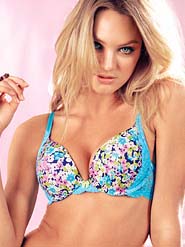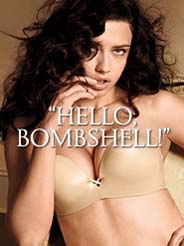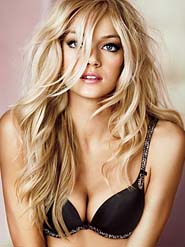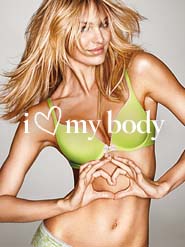
The Secret That Sells:
Psychoanalysis, Discourse Analysis, and Audience Studies of Victoria's Secret Advertisements

The Secret That Sells:
Psychoanalysis, Discourse Analysis, and Audience Studies of Victoria's Secret Advertisements
Paralleling Victoria's Secret's rise in fame and recognition over the years has been its increase in provocative advertisements available to the public. The annual Victoria's Secret Fashion Show, the monthly catalog, and the variety of commercials are just some of the ways in which Victoria's Secret is taking over the world. Simultaneously, its ability to position women in compromising positions and incite scopophilia in viewers has given Victoria's Secret the power to encourage women and men that its models have the ideal body type for women, setting a virtually unattainable standard.
This site contains different images and analyses on the Victoria's Secret advertisement campaigns. While many of the details in the photographs and commercials seem insignificant, they can, in fact, dictate how many think about the ideal standards of femininity. These analyses apply to the entirety of American society--anyone who buys into, feeds into, or is subjected to, whether voluntarily or involuntarily, the archetypes of beauty that Victoria's Secret creates as a result of its advertising. They are meant to reveal certain stereotypes of women and the "ideal" woman that are both reinforced and created by Victoria's Secret in the advertising world.
As a result of the various types of analyses, explanations of interpellation, and descriptions of several images within Victoria's Secret advertising, a viewer should be able to understand the effects that the lingerie store has on American views of women and feminine standards of beauty in society. These "images can bring people, places and things close to the viewer or 'keep them at arm's length,'" allowing the viewer to both see the details up close and interpret the visual as a whole from a distance (Jewitt 146).
By observing the various images with a Victoria's Secret advertisement campaign, it is possible for both men and women to recognize the inherent relationship that exists between an image and its viewer, the symbolic and the real, in order to determine what it is about an image that is eye-catching. These analyses should lend audiences the ability to comprehend what interpellates them in an ad and what social constructs are perpetuated and developed around the images that they are viewing.
With audiencing, or audience studies, it is important to note an advertiser's connection with its audience. The ideas of scophophilia and voyeurism come into play with both audiencing as well as psychoanalysis. While the theories of phallocentrism and the castration complex are only that, theories, they still lend the audience a method in which to approach a psychoanalytic observation of an image or set of images. The discourse analysis of the Victoria's Secret advertisements is mainly a way for audiences to uncover why they strive to look like or to attain a body like the ones featured on the models in the lingerie advertisements.
Victoria's Secret is a known powerhouse of lingerie sales, but through a set of various types of analyses, it is possible to unearth Victoria's Secret's contributions to female sexual identities in America, stereotypes associated with women and their bodies, and the ways in which males view women from a distance with an unconscious sense of desire and fantasy.
 |
 |
 |
 |
 |
| Psychoanalysis | Discourse Analysis | Audience Studies | Interpellating Men/Women |
I Love My Body |
Lacan, Jacques. Feminine Sexuality. Ed. Juliet Mitchell and Jacqueline Rose. Trans. Jacqueline Rose. New York: W. W. Norton &, 1985. Print.
Rose, Gillian. "Visual Methodologies: An Introduction to the Interpretation of Visual Materials". 2nd ed. London: SAGE, 2007.
http://glassesetc.webnode.com/news/all-secrets-of-victorias-secret/
http://www.victoriassecret.com/
May 2, 2011